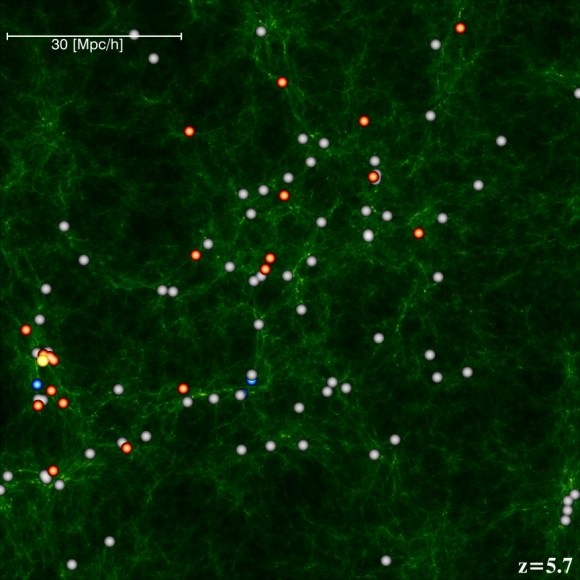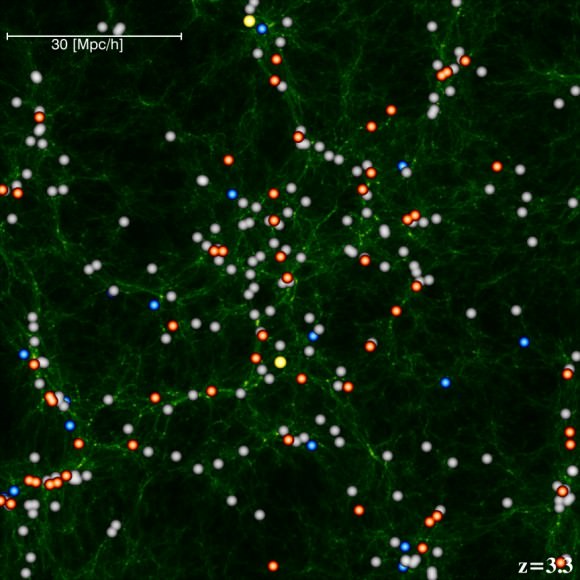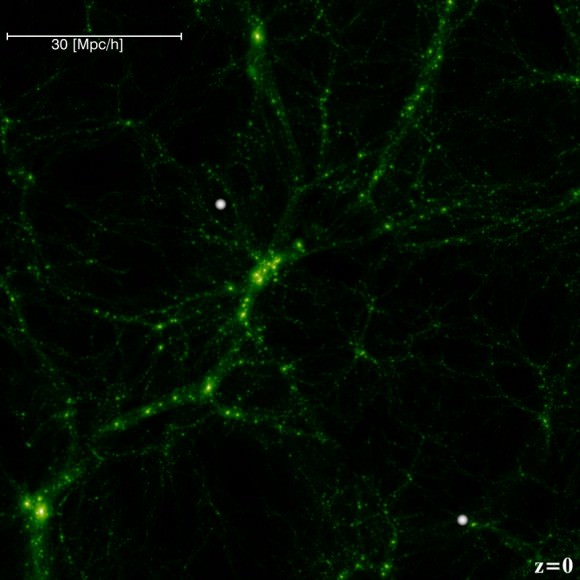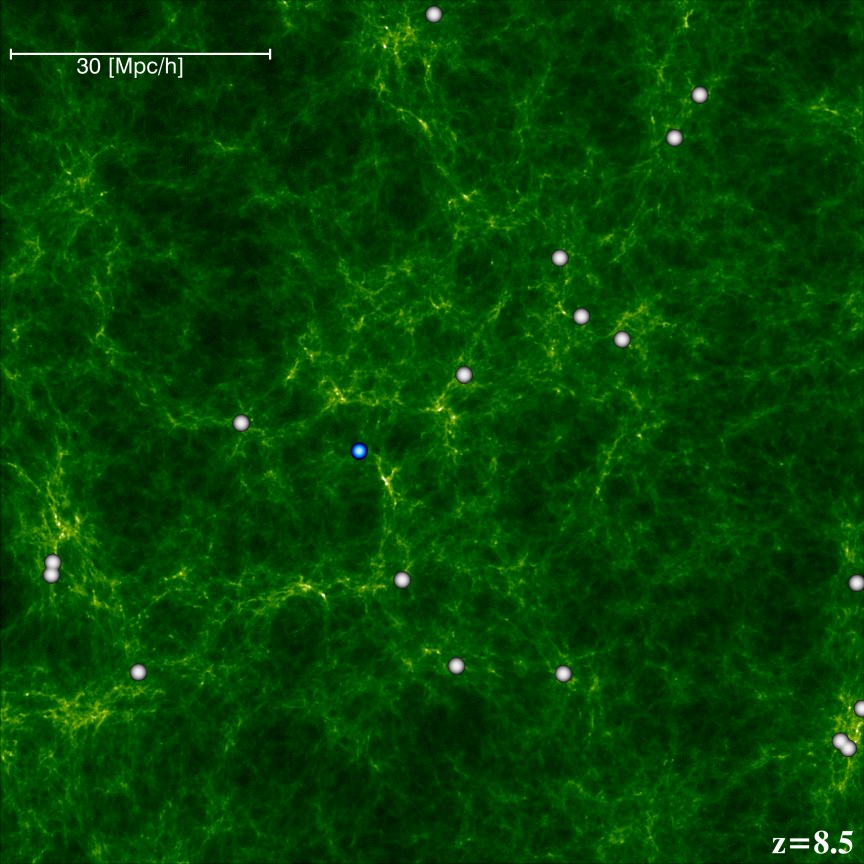[/caption]
What did the Universe look like early in its history, only 500 million years after the Big Bang? Currently, we have no way of actually “looking” back that far with our telescopes, but cosmologists from Durham University in the UK have used a computer simulation to predict how the very early Universe would have appeared. The images portray the “Cosmic Dawn,” and calculate the formation of the first big galaxies. The simulation also attempts to discern the role that dark matter played in galaxy formation. “We are effectively looking back in time and by doing so we hope to learn how galaxies like our own were made and to understand more about dark matter,” said Alvaro Orsi, lead author of the study from Durham University’s Institute for Computational Cosmology (ICC). “The presence of dark matter is the key to building galaxies – without dark matter we wouldn’t be here today.”
In the images produced by the computer simulation, the green swirls represent dark matter, which the scientists say is an essential ingredient in galaxy formation, while the circles show the star formation rate in galaxies. The different color circles represent the varying luminosity of star formation with yellow being brightest. The top image portrays the Universe as it was 590 million years after the Big Bang, and the image below shows the Universe 1 billion years after the Big Bang, as star formation rates begin to ramp up.

The very first galaxies were created from the debris of massive stars which died explosively shortly after the beginning of the Universe. The Durham calculation predicts where these galaxies appear and how they evolve to the present day, over 13 billion years later. Although the galaxies today are bigger, they are not forming stars as quickly now as they were in the past. “Our research predicts which galaxies are growing through the formation of stars at different times in the history of the Universe and how these relate to the dark matter,” said co-author Dr. Carlton Baugh. “We give the computer what we think is the recipe for galaxy formation and we see what is produced which is then tested against observations of real galaxies.”
The massive simulation shows how structures grow in dark matter with a model showing how normal matter, such as gas, behaves to predict how galaxies grow. Gas feels the pull of gravity from dark matter and is heated up before cooling by releasing radiation and turning into stars. The simulation images show which galaxies are forming stars most vigorously at a given time. The image below shows the Universe 1.9 billion years after the Big Bang, a very active time of star formations in galaxies.

The calculations of the Durham team, supported by scientists at the Universidad Catolica in Santiago, Chile, can be tested against new observations reaching back to early stages in the history of the Universe almost one billion years after the Big Bang. Professor Keith Mason, Chief Executive of the Science and Technology Facilities Council, said: “Computational cosmology plays an important part in our understanding of the Universe. Not only do these simulations allow us to look back in time to the early Universe but they complement the work and observations of our astronomers.”
This image shows the Universe today, 13.6 billion years after the Big Bang. Galaxies are not forming stars as quickly now as they were in the past.

The team hopes that further study and simulations of effects of dark matter on galaxies will help astronomers learn more about what this ubiquitous substance is.
Source: Science and Technology Facilities Council
Institute for Computational Cosmology, Durham University
Department of Physics, Durham University


Fantastic stuff! But just like with all computer simulations s#&* in s#&* out. NIce to see and read – hard to belive
btw . this is a amazing web site .
Have you written a lot of computer simulations?
“The presence of dark matter is the key to building galaxies – without dark matter we wouldn’t be here today.”
-wow. that’s quite a bold statement.
A lots of neurons !
Dentrite , Nucleus , Axon and soma !
Where I’m from (The Land of Science) our method requires physical observation and not blind computer imagination.
Since when did observation and telescopes get sacrficed on the Altar of Big Bang mythology?
This ought to be the subject of scholarly investigation.
Very impressive, and new…. I think that more the astronomers are discovering through telescopes, scientists then put massive data together to get global cosmic behavior like this….
Its a remarkable. I’m certain the future of cosmology lays in this direction.
Simulations like this are based upon mathematical models of the universe – and as our models improve, so our view of the early universe continues to become clearer.
These are not speculative simulations with variables tweaked to change the outcome to what we expect to see – but theoretical mathematical models allowed to evolve (or run in reverse) so that we are able to observe what would otherwise be impossible to observe.
Fantastic stuff!
Nice images, but as was said, garbage in – garbage out.
Until the model is based on plasma physics magnetism, electric currents and zpinches, the resulting images will be nothing more than computer art.
Gravity is a weak force at inverse square to distance, electric current and magnetism at inverse to distance, an order of magnitude more powerful, and will eventually prove to be the ‘dark energy/matter’ the cosmologists have imagined into existence.
“… electric current and magnetism at inverse to distance …”
Not exactly.
Coulomb’s Law: The magnitude of the electrostatic force between two point electric charges is directly proportional to the product of the magnitudes of each of the charges and inversely proportional to the SQUARE of the total distance between the two charges.
I think it would have been nice if they have made it more realisitic and testable like if they could match up with observations…And these look remarkably similiar to the millienium simulation as well….(refer http://www.mpa-garching.mpg.de/galform/millennium/)
I wonder at the difference between the two!!
Correct me if Im wrong, but didnt the universe go dark after the first 350,000 years, and remain dark for about a billion years? Perhaps my timeline is off.
God. Another POS computer simulation….
Well at least the dark matter model has at least a model that can be tested.
Unlike some other holistic theories where we find complete no evidence for and no one knows exactly how it works and looks like.
There isn’t one square centimeter of science which doesn’t use computer simulations. In this case, it isn’t meant to be an exact representation, but an explicit model of probable actions.
With the amount of time we’ve been studying the universe, there isn’t enough data to do anything better. There isn’t even a conclusive history of our own solar system going back 1000 years.
To totally dismiss this simulation is just as foolish as believing every bit of it. Certainly there are some things missing, but as well, there are many things which are going to be found “spot on”.
Simulations have given us pretty good insight to many things in the universe. Black holes just to name one. Simulations also predicted gravitational lensing. I remember individuals stating GBGO on it.
Nothing wrong with being skeptical, but being dismissive displays you aren’t very scientific. Pessimism doesn’t bring on new discoveries. Don’t be shocked if someone builds off of this simulation and discovers something remarkable. It wouldn’t be the first time.
When you work in the astronomy business, you learn to live with becoming more ignorant every day. For many of us, this is one of the most exciting aspects of this science.
I’ve written a few simple computer simulations, and it is interesting. More and more data will change the calculations and paramenters to attempt to figure out what happened, but like trying to figure out what the weather will be in 7 days, it will NEVER be possible to get it exactly correct. They will get a ‘general’ idea what happened, but like climatology, for instance, in a Mediterranean climate where I live, Sacramento, Ca US, it will be cool and moist in winter, while it will be dry and hot in summer .
An impressive show of computational power, to be sure. And it probably has some elements of fact and observable science in it. But not much, I bet.
However, our computer models, swell as they are, can’t even predict weather very well 5 days or more into the future (as someone has pointed out already), so it doesn’t seem likely that we can honestly compute the past 15 billion years of the universe. Well, let’s be honest; we can’t. There are so, so, so many variables we are not aware of and physics that we don’t yet understand (or even realize that we don’t know or understand)
But this is, I suppose, really just an academic exercise and an *early* attempt to resolve the dynamics of the universe. I say ‘godspeed’ to all who attempt to understand this wonderful place we reside. And my they realize how much they don’t yet know…
Bravo, Aodhhan!
Well said. Why must we be for or against, can’t we just take what we can from all sources? My mommy wasn’t right about everything either, but I still listen well when she has something to impart to me!
Aodhhan
Peter
I have said many times on other feeds I’m not anywhere near an expert with gravity or electric-plasma or many spectrums of the Advanced Science spectrum-if Moores law of computing power which may end 2019 with current technology, can be overcome by using Optical or Quantum conputers, then Moores laws of computing power may continue (2x power 1/2 cost every 18months) for well more than 100 Moores’ cycle, or about 150 years,-by 150 years , the amount of new discoveries and information gathered to change calculations and parameter changes with different varibles will by then give science a good ‘General’ Idea how the Universe appeared per this feed- however, even with another 100 Moores cycles, the end results will not change that much more and may appear to most to be a matter of diminishing returns as the ‘General’ ideas will really not change that much on the big picture. I like the idea of trying to know what the Universe ‘truely’ looked like per this feeds age, – I admit there will be refindments made but still -like the weather forecast for 7 days ahead, it will be impossible to get the weather results completely correct due to the laws of chaotic behavior on the sub-atomic levels, and that goes for attempting to get a correct picture of our early Universe although it will be quite interesting. I am quite certain by 100 cycles, every well knowledgable Astro-physics and other high Science research Specialist will have different ideas on their calculations,varibles and will use the vast amount of computer power resources avaible to have their hypothesis tested , viewed and published-however, IMHO, to a lay person, they will appear quite similar.
Research will of course continue after the 100 cycles and more discoverys and findings will constantly change the calculations,etc.
Of course, any Scientist of purdent thinking will never say ‘this is how the Universe exactly looked—–what, U question my findings,this is what the computer says!!! lol!
Computer simulations is very important not just for figuring out how our Universe was,but can have very practical applications on ways to rid our Earths’ outerspace of space junk, and will be very helpful to truly calulate the risk,other factors on Science and Enginering perjects not now available
The topic is quite trendy in the net right now. What do you pay attention to when choosing what to write about?